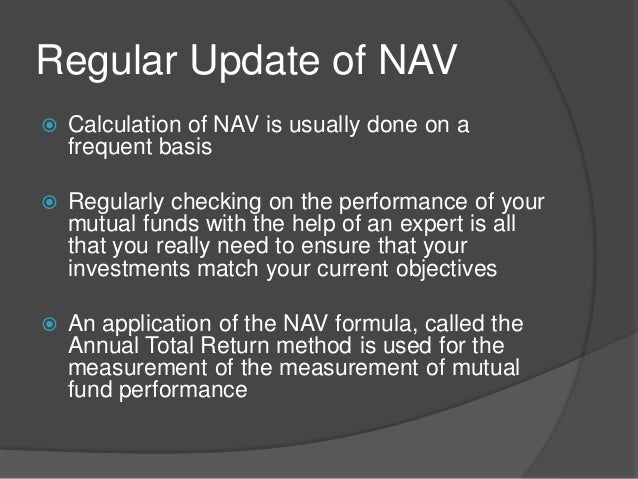What Is Net Asset Value (NAV)? A Focus On The Amundi Dow Jones Industrial Average UCITS ETF

Table of Contents
What is Net Asset Value (NAV)? A Detailed Explanation
Net Asset Value (NAV) represents the net worth of an investment fund, such as an ETF, per share. It's calculated by subtracting the fund's liabilities from its assets. Understanding NAV is vital for assessing the true value of your ETF investment.
Calculating NAV: Assets Minus Liabilities
The fundamental formula for calculating NAV is simple:
Assets - Liabilities = NAV
Let's break down the components:
-
Assets: For an ETF like the Amundi Dow Jones Industrial Average UCITS ETF, assets primarily consist of the underlying securities it holds. In this case, that would be a portfolio mirroring the Dow Jones Industrial Average, including shares of companies like Apple, Microsoft, and Nike. Other assets might include cash holdings.
-
Liabilities: These are the fund's outstanding debts and obligations. Common liabilities for ETFs include management fees, administrative expenses, and accrued expenses payable.
Example:
Let's say an ETF has total assets of $10 million and liabilities of $100,000. The NAV would be: $10,000,000 - $100,000 = $9,900,000.
NAV per Share: Dividing the Pie
The total NAV is then divided by the number of outstanding shares to determine the NAV per share. This is the figure most relevant to individual investors. Using our example, if there are 1 million outstanding shares, the NAV per share would be $9.90.
Daily NAV Calculation: A Daily Snapshot
The NAV of an ETF, including the Amundi Dow Jones Industrial Average UCITS ETF, is typically calculated daily, usually at the market close. This reflects the closing market prices of the underlying assets. This daily NAV calculation provides a consistent measure of the fund's value.
Impact of Market Fluctuations: The Market's Influence
Market fluctuations directly impact the NAV. If the value of the underlying assets in the ETF increases, the NAV will rise. Conversely, a decline in the market value of those assets will decrease the NAV. Understanding this relationship is crucial for interpreting daily NAV data and managing investment risk.
Net Asset Value (NAV) and the Amundi Dow Jones Industrial Average UCITS ETF
The Amundi Dow Jones Industrial Average UCITS ETF, like all ETFs, is structured to provide transparent and efficient access to the Dow Jones Industrial Average. This structure directly influences its NAV calculation.
ETF Structure and NAV: Transparency and Efficiency
ETFs are designed for transparency. Their holdings are publicly disclosed, making it straightforward to track the assets that contribute to the NAV calculation. This contrasts with some other investment funds where the precise composition is less readily available.
Transparency of NAV: Open Access to Information
The NAV of the Amundi Dow Jones Industrial Average UCITS ETF, and most other ETFs, is readily accessible through various financial websites and the ETF provider's website. This public availability enhances investor confidence and facilitates informed decision-making.
Using NAV to Track Performance: Monitoring Your Investment
Investors can use the daily NAV data to monitor the Amundi Dow Jones Industrial Average UCITS ETF's performance over time. By tracking the changes in NAV, one can gauge the effectiveness of their investment and compare it against benchmarks.
Comparing NAV to Market Price: Slight Deviations
While the NAV should be a close approximation of the market price of the ETF, minor discrepancies can occur. This is usually due to factors like intraday trading and the time lag between the market closing and the NAV calculation.
Understanding NAV and Making Informed Investment Decisions
Regularly monitoring the NAV of your investments, including the Amundi Dow Jones Industrial Average UCITS ETF, is essential for effective investment management.
Importance of Monitoring NAV: Staying Informed
By tracking the NAV, you can identify trends, adjust your investment strategy, and potentially mitigate risks. Consistent monitoring allows you to react appropriately to market changes and to your portfolio's performance relative to your goals.
NAV and Investment Strategies: Guiding Your Approach
Understanding NAV can help refine investment strategies. For example, some investors might use NAV to implement dollar-cost averaging, buying more shares when the NAV is lower. Others might use it as a key indicator for rebalancing their portfolio.
Risk Management and NAV: Mitigating Potential Losses
Monitoring NAV helps in risk management. A significant and persistent decline in the NAV could signal the need to re-evaluate your investment strategy or even consider selling part or all of your holdings.
Resources for Finding NAV: Accessing Key Information
You can find the daily NAV of the Amundi Dow Jones Industrial Average UCITS ETF and other ETFs on the Amundi website, major financial news websites, and through your brokerage account.
Conclusion: Mastering Net Asset Value (NAV) for Successful ETF Investing
Understanding Net Asset Value (NAV) is fundamental to successful ETF investing. We've explored how NAV is calculated, its significance for tracking performance, and its application to the Amundi Dow Jones Industrial Average UCITS ETF. Regularly monitoring the NAV, combined with other analytical tools, allows investors to make informed decisions, manage risk effectively, and potentially maximize returns. Learn more about NAV and its crucial role in your ETF investment strategies, using the Amundi Dow Jones Industrial Average UCITS ETF as a practical learning point, to elevate your investment expertise. Invest in ETFs wisely, understand ETF NAV, and make informed choices about your financial future.

Featured Posts
-
 Avoid Memorial Day Travel Rush Best And Worst Flight Days In 2025
May 25, 2025
Avoid Memorial Day Travel Rush Best And Worst Flight Days In 2025
May 25, 2025 -
 France L Etendue De L Influence Chinoise Et La Repression Des Voix Discordantes
May 25, 2025
France L Etendue De L Influence Chinoise Et La Repression Des Voix Discordantes
May 25, 2025 -
 West Ham United Makes Formal Offer For Kyle Walker Peters
May 25, 2025
West Ham United Makes Formal Offer For Kyle Walker Peters
May 25, 2025 -
 Analisis Saham Mtel And Mbma Setelah Termasuk Dalam Msci Small Cap
May 25, 2025
Analisis Saham Mtel And Mbma Setelah Termasuk Dalam Msci Small Cap
May 25, 2025 -
 Elektromobiliu Ikrovimas Europoje Porsche Plecia Tinkla
May 25, 2025
Elektromobiliu Ikrovimas Europoje Porsche Plecia Tinkla
May 25, 2025
Latest Posts
-
 Piazza Affari Borsa In Attenzione Per Decisione Fed
May 25, 2025
Piazza Affari Borsa In Attenzione Per Decisione Fed
May 25, 2025 -
 Borsa Europea Attenzione Fed Banche Deboli Italgas In Luce
May 25, 2025
Borsa Europea Attenzione Fed Banche Deboli Italgas In Luce
May 25, 2025 -
 Strong Heineken Revenue Growth Company Confident Despite Tariff Headwinds
May 25, 2025
Strong Heineken Revenue Growth Company Confident Despite Tariff Headwinds
May 25, 2025 -
 Heinekens Q Quarter Results Revenue Beats Estimates Outlook Confirmed
May 25, 2025
Heinekens Q Quarter Results Revenue Beats Estimates Outlook Confirmed
May 25, 2025 -
 Heineken Revenue Surpasses Projections Outlook Remains Strong Despite Tariff Challenges
May 25, 2025
Heineken Revenue Surpasses Projections Outlook Remains Strong Despite Tariff Challenges
May 25, 2025
